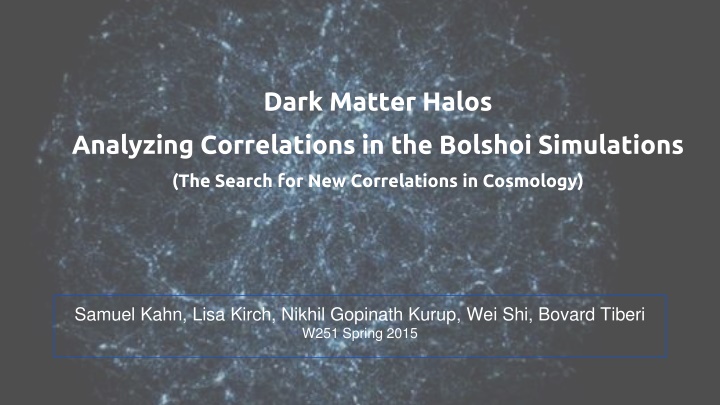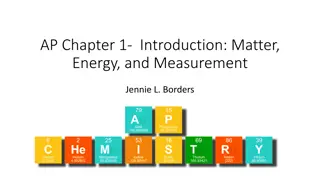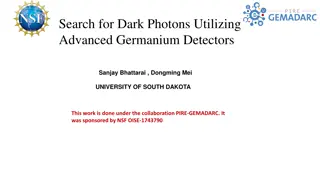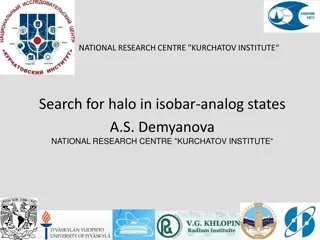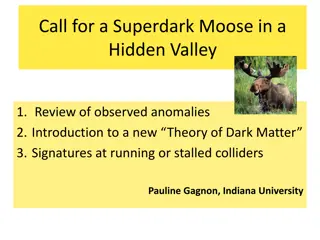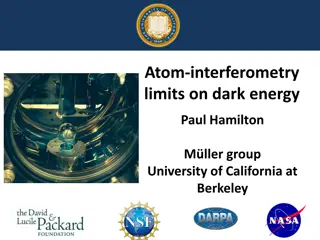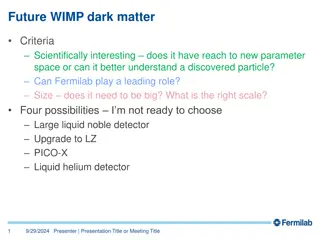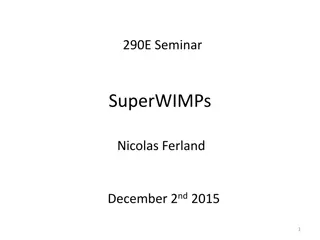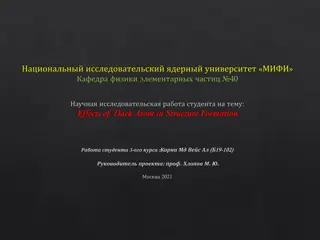Dark Matter Halos
This study delves into the correlations within dark matter halos using data from the Bolshoi Simulations. Explore the significance of halo shape, envelope characteristics, and the proposed analysis on evolving galaxy features. Uncover the tools utilized for data management, computing, and statistical analysis in this cosmological research project.
Download Presentation

Please find below an Image/Link to download the presentation.
The content on the website is provided AS IS for your information and personal use only. It may not be sold, licensed, or shared on other websites without obtaining consent from the author.If you encounter any issues during the download, it is possible that the publisher has removed the file from their server.
You are allowed to download the files provided on this website for personal or commercial use, subject to the condition that they are used lawfully. All files are the property of their respective owners.
The content on the website is provided AS IS for your information and personal use only. It may not be sold, licensed, or shared on other websites without obtaining consent from the author.
E N D
Presentation Transcript
Dark Matter Halos Analyzing Correlations in the Bolshoi Simulations (The Search for New Correlations in Cosmology) Samuel Kahn, Lisa Kirch, Nikhil Gopinath Kurup, Wei Shi, Bovard Tiberi W251 Spring 2015
Agenda Background - What are Dark Matter Halos? Proposed Analysis - Why is it important? Data - transfer, storage and management Compute - planning and orchestration Data Crunching o Correlation Analysis o Feature Importance Outcome and Next Steps
Dark Matter Hypothetical, invisible matter that only interacts gravitationally 27% of matter in the universe Explains the structure of the universe and the rotation of galaxies Why do we care about Halo Shape? o Nurseries for galaxies
Dark Matter Halos Envelope of dark matter around galaxies Dominates the mass of a galaxy Explains the rotational velocity discrepancy in galaxies
Bolshoi Simulation A series of simulations of the universe Seeded with 8.6 billion dark matter particles , each 200 million solar masses Initial condition of the universe constantly refined by observational data State of the universe measured at 180 time intervals from Big Bang to current time Each measurement tracks 76 features of about 20 Million halos each
Proposed Analysis As the universe expands the relative influence of different features changes over time (e.g. weak forces vs gravity) Does the importance of halo features change over time? If so how? This could help in understanding the evolution of galaxy sizes and shapes
Tools Used Data transfer - FTP, rsync, scp, Netcat Data storage - Block storage, HDFS cluster Cluster provisioning - Vagrant, Puppet, ansible Scalable computing - Hadoop with Yarn, Spark Statistical analysis and Machine learning - MLlib, NumPy, SciPy, pandas, PySpark Programming languages - Scala, Python IDEs - Eclipse, IPython, PyCharm Build and deployment - sbt, shell scripts Monitoring - nmon Collaboration - ISVC, Google Drive, Google Hangouts, Speek.com, Email Source code hosting - Github
Data Transfer - 180 files in FTP server that we transferred - Total data volume = 2 TB - Transferred using scp - Time taken for transfer approximately 6 hours
Data Storage and Management Data stored in a block storage in Softlayer attached to a Ubuntu server node. The block storage node could be reattached to different cluster master nodes based on computing needs Moved to HDFS cluster with replication using shell scripts right before computation Also moved piecemeal files to individual cluster nodes for data locality
Data Processing Python scripts used to o Cleanup individual data files o Remove superfluous features from analysis (ids, etc.) o Filter out halos with masses less than 10^10 solar mass (roughly the mass of the Milky Way) o Reduce the data size 500%, from 2TB to 308 GB o The data is partitioned across 180 timesteps o No normalization is needed as PCA was abandoned
Cosmological Scale Data from the simulations were collected at discrete time steps known as the cosmological scale factor and recorded. This gives us the view of the universe during different points in time which can then be validated observations. This data was found to be be in observations and predictions and give a deeper understanding of how the structure of the universe has ensued. against agreement with
Preprocessing The algorithms which determine the shape of the dark matter halos are not accurate for small halos because they do not contain a lot of particles and are thus not well- defined. So, we limit our analysis to halos which are only larger than 10^10 solar masses. This allows us to analyze those halos that are well- defined and reduces the size of our data. The amount the data size reduced by preprocessing decreases log-linearly with each timestep.
Cluster Orchestration Customized version of vagrant-cluster1with additional support for Creating a cluster in the existing VLAN Cluster communication over private VLAN Auto attach and mount data block storage to master node Install additional python libraries 1 -https://github.com/irifed/vagrant-cluster
Correlation Analysis In a given instance/time-step, how correlated are the independent features? Create a 62x62 grid of Pearson correlation for each of the 180 time steps Plot and observe the changes in correlation over time Three attempts o PySpark with scikit-learn - Memory errors o Spark with Scala - 20 node/16 cores/ 16GB - 13 days o NumPy and shell - 6 node/ 8 cores/32GB - 15 hours
Correlation Output max@Mpeak(71 ) -3.09E-15 -0.02980431 -3.07E-15 -0.06042489 -0.04288056 --- #scale(0) id(1) desc_scale(2) num_prog(4) phantom(8) sam_mvir(9) --- max@Mpeak(71 ) id(1) desc_scale(2) 3.04E-15 num_prog(4) phantom(8) sam_mvir(9) -2.78E-16 --- -0.09166446 --- 9.27E-17 --- 0.1182337 --- --- 1 1 9.99E-17 -0.04436117 -6.28E-17 3.04E-15 1 -2.97E-15 1 -2.97E-15 -0.04436117 -0.09166446 1 9.99E-17 -2.78E-16 -6.28E-17 9.27E-17 1 0.1182337 1 --- --- --- --- --- --- --- -3.09E-15 -0.02980431 -3.07E-15 -0.06042489 -0.04288056 --- 1 180 62x62 NumPy correlation files generated - 8MB each Initial analysis points to the emergence of some patterns
Correlation Output The halo shape starts out negatively correlated with the radius of a halo and gradually becomes positively correlated as The Universe evolves. The correlation between the shape and speed at which the particles inside the halo are moving start out positively correlated, becomes negatively correlated, and than gradually becomes positively correlated as The Universe evolves.
Feature Importance Three attempts PCA - Reduction of the dimensionality makes feature importance less meaningful PySpark - OutOfMemory exception persists for large files with >500MB Scala - 11 machine (100 GB HDD, 4 GB RAM, 2 cores) Spark cluster Ended up using DTs on Spark in scala 1 run = 13 hours on 11 node-cluster
Feature Importance 1. init array of 0s 2. recurse through 3. add gain to arr[ftr#] feature: 1 gain: 254 feature: 8 gain: 274 feature: 3 gain: 343 feature: 2 gain: 124 feature: 4 gain: 234 feature: 5 gain: 167 feature: 9 gain: 97
Feature Importance Results Surprisingly, the halo shape seems to be highly dependent on the x, y, and z coordinates of the halo in the simulation. This dependent on the position of the halo in the Cosmic Web and the way matter is flowing into the halo. likely means that halo shape is highly We also find that halo shape is highly dependent on how long ago a halo merged with another halo, its velocity in space, momentum, and its spin. its mass, its angular
Conclusion and Next Steps 1. BIG Data 2. Interesting Problem 3. Great Team 4. Results! Next Step: Further Analysis
